|
Some Steam hauled trains
in Australia
|
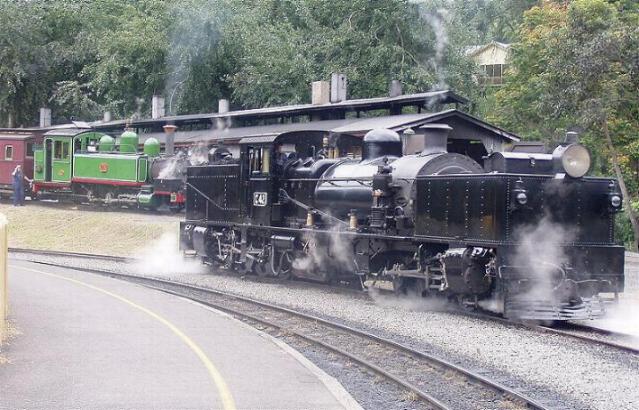
|
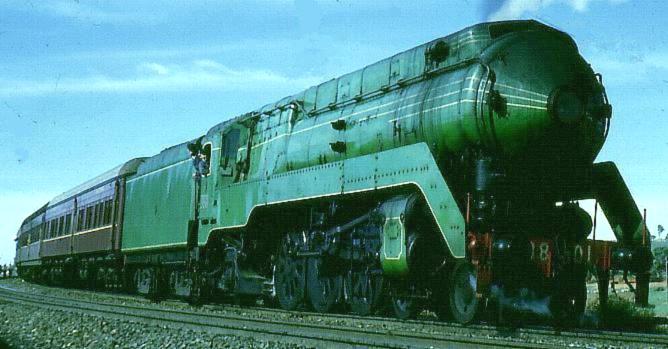
|
|
The New South Wales Railway's C38 Class
There
were 30 4-6-2 locomotives in the 38 class. Many considered these as
the pinacle of Australian steam locomotive development. They were built
under the New South Wales Railways Chief Mechanical Engineer, Harold Young
with the first five being built by Clyde Engineering Co. between 1943
and 1945 under Wartime conditions. These were streamlined with a bullet nose
with central headlight and casing along the top of the boiler. Thirteen
more were built by NSW railway workshops at eveleigh, while the railway
workshops at Cardiff built a further 12. The later two batches, were minus
the streamlining mentioned above. The weight of these locos was around 200
tons which restricted the number of lines on which they could operate.
They were not fitted with mechanical stokers eventhough the
grate area was some 47 square feet. The 38s became the locos of the Melbourne
Limited, the Riverina and other major trains on the Southern line, as well
as on the Newcastle line and the Central West Express. Although the driving
wheel diameter was 5ft 9inches, the 'pacifics' kept to 70 MPH
schedules and speeds over 80 MPH were recorded. Dieselisation, rendered
these locos to lesser passenger duties and to freight service.
Boiler pressure was 245 lbs sq. in., the highest of any
Australian loco. Cylinders were 21 1/2" X 26" and
tractive effort was 36,200 lb. In 1970, 3801 was the first steam
locomotive to travel across the continent from Sydney to Perth and return
on the new standard gauge track. At least three C38s have been
preserved: 3801, 3820 and 3830.
|
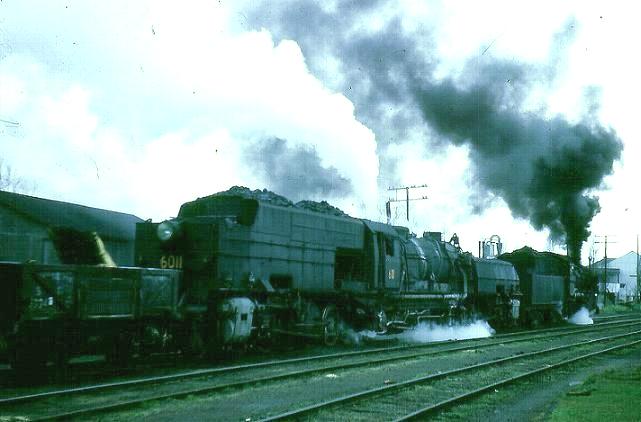
|
Garratt Loco - New South Wales
These
AD60 class locos, with the wheel arrangement of
4-8-4+4-8-4, and tractive effort of 63,000 lbs, were the most powerful
steam locomotives in Australia. The total weight of each was some 265 tons
with a length of 108 feet.
There were 42 in the class. --Built by Beyer Peacock (UK) the first
were delivered in 1952.
They were the first Garratts to be to be provided with cast-steel
engine frames and integrally cast cylinders.
They were intended for the hauling of coal and for operation over
the Blue Mountains
West of Sydney, but they were soon hauling heavy freight over most
of the NSW rail system. Despite their huge weight, they had a light
axle load, which suited them to wheat traffic, concentrates, and general
traffic. The decline of the class began in 1955 when many were rendered
surplus by dieselization soon after they were assembled. The
AD60 class remained in service in diminishing numbers until 1970.
At least 4 have been preserved:
6029, 6039, 6040 and 6042.
Other Details: Driving wheel diameter 4' 7",
Cylinders: 19 1/4" X 26",
Boiler pressure 200 lb.
|
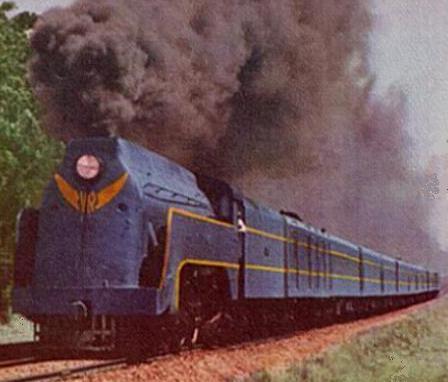
|
|
Australia's first all steel
air conditioned train
|
It commenced the run of about 200 miles non stop between Albury and
Melbourne in 1937. The Loco is a three cylinder 4-6-2 of which there
were four numbered S300 to S303.
The third cylinder was in the center and operated onto the cranked
center driving axle.
The S class, were designed by Mr. E.A. Smith who was chief mechanical
engineer of the Victorian Railways from 1919, to 1928.
The S class locos eliminated costly double heading of the Sydney Limited.
They were built at the Victorian Railway's Newport workshops
Melbourne between 1928-33 and were streamlined between 1936-38 to haul
the new train. The airconditioning and electric power was provided
by axle driven equipment beneath each car.
The locomotive tenders were enlarged to 35 & a half feet and fitted with
2 six wheel bogies to carry enough water for non stop running to Albury
on the Victoria/New South Wales border.
At the time, coal capacity was reduced from 9 tons to 7 and a half tons,
but water capacity was increased from 8,600 gallons.
At Albury, passengers changed between
trains on the five foot three gauge and the 4 foot eight & 1/2" NSW gauge
for continuation of their journey to or from Sydney the NSW capital.
Here are details of the locos: Cylinders (3) 20 & one half inch diameter;
28 inch stroke, Driving wheels 6 foot + 15/16" diameter; engine & tender
76 feet; Engine weight 114 tons 10cwt; tender 109tons 7 cwt - total
223 tons 17cwt; Adhesive weight 70 tons 10cwt; axle load (max) 23
tons 10 cwt; Boiling heating surface - Flues and tubes 2,861 sq ft;
firebox 292 sq ft; superheater 570 sq ft - total 3,723 sq ft; grate area
50 sq ft; Boiler pressure 200 lb sq in; tractive effort at 85% boiler
pressure 41,670 lb; tender capacity 12,600 gallons water, oil 2,000
gallons; Valve gear Walschaert; Speed 70 miles per hour;
S301 (Sir Thomas Mitchell, built 1929), with worn cylinders due for
replacement, and a mileage of 1,147,408 was the first of the class to
be scrapped in October 1953. Usable parts were stored for possible
further use.
S302 (Edward Henty, built 1929) during its life of 25 years, held the
greatest mileage with a total of 1,446,468. It was scrapped in July 1954.
S300 (Matthew Flinders, built 1928), after covering 1,254,806 miles, was
withdrawn from service on September 17, 1954.
S303 (C.J. Latrobe, built 1930), with a mileage of 1,139,978 was scrapped
in May 1954.
The four S class were converted from coal to oil in 1951-52.
Newly introduced Diesel electric locos took over the run.
Some eight years later, the 4'8 & 1/2 gauge was extended from Albury to
Melbourne and interstate trains now run through although the 5'3"
gauge is still used by Albury trains.
|
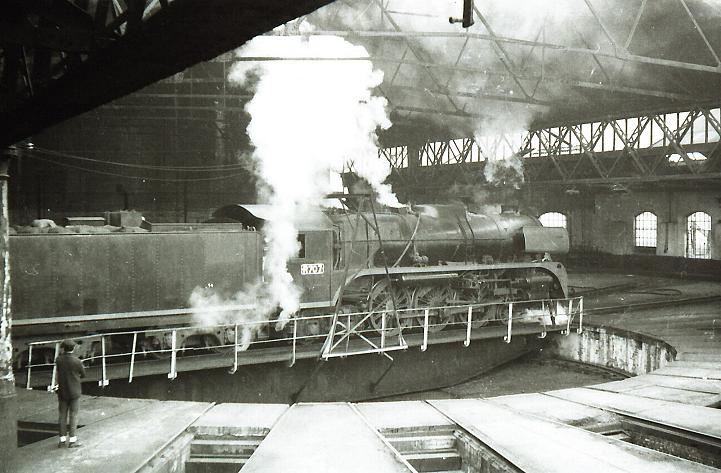
|
Victorian Railway's R class
The locomotives of the 'R' class were designed as fast passenger train
engines. They were built by the North British Locomotive Co.
of Scotland. Seventy arrived in Australia in the
early 1950s at about the time diesel electric
locomomotives were being introduced. The R class therefore had
limited use on passenger trains and they ended their days mainly
on freight trains.
They are the only 4-6-4 tender type locomotives to work in Australia.
Some seven of these have been preserved with some operational.
They were designed with mechanical stokers and roller bearing axle boxes on
loco and tender. They were designed for possible conversion from broad gauge
(5' 3") to standard gauge (4' 8 1/2") should the
need have arisen.
Two, R711 and R766 were converted to oil burners in the former West Coast
Railway workshops at Ballarat in the 1990s to run tourist
services on the Warnambool
line. The Warnambool line las reverted to VLine control and diesels
now run all regular services.
R711, was fitted with a consul to enable a
diesel electric, operating as second loco, to be controlled
by the R711's driver.
R766 was on static display in a park near Bendigo Railway station
before it was returned to service firstly as a coal burner. It
was replaced in the park by R711. R711 was later also retreived and
restored to operation. Details: Driving wheels 6' 1",
Cylinders: 21 1/2 X 28 inches,
Boiler pressure: 210 p.s.i., Weight 187 tons,
Tractive effort 32,080 lbs. The picture above is of
R707 on the turntable at Ballarat before the loco shed was demolished.
 R749 prepares
to Lead another of its class
from Ballarat to Melbourne R749 prepares
to Lead another of its class
from Ballarat to Melbourne
|

|
|
This Tasmanian Government Railways Australian Standard Garratt no. G12,
was stored out of service in this siding at Wynyard about 1960.
It was was purchased by the privately run minerals carrying railway --
The Emu Bay Railway in June 1962 to became no.20A,
(pictured below) as the replacement of their
locomotive no.20 of the same class, which was wrecked in a downhill
runaway on the long grade approaching Burnie on February 20 1962.
The purchase of this locomotive was a measure to overcome a motive power
shortage. Diesel hydraulic locomotives began to arrive in August 1963 and the
first of four operating EBR Garratts, (no.16) was withdrawn, the other
three, including 20A, being withdrawn in September 1963.
Although no.16 was withdrawn in August 1963, It was used to operate
an enthusiast's special to Zeehan on the West Coast in March 1964.
The H and M class in two pictures below, are an earlier earlier part
of that tour.
|
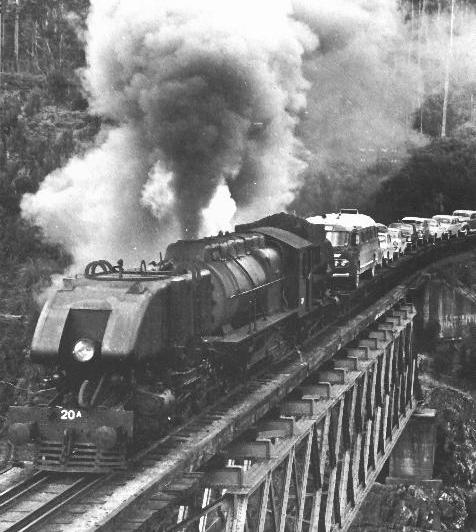
|
Australian Standard Garratt 3ft 6in gauge on Pieman River
Bridge West Coast Tasmania in February 1963.
Motor vehicles were carried on this railway before the highway was
completed soon after this photo was taken.
These 4-8-2+2-8-4 locomotives were built during World War II in Australia and
served in Queensland, Western Australia, South Australia and
Tasmania -- where they were most successful. One unit worked
on a private limestone quarry line at Geelong Victoria. This one was kept
longer than the others and is consequently the only survivor, and presently
on display at the Railway museum, Williamstown Victoria.
As a matter of interest, the driving wheels on the ASGs, is of the same pattern
and diameter as on the Western Australian 'S' class locos which entered
service about the same period in the 1940s.
Click here to see S547 awaiting
restoration on the Bellarine Peninsula Railway in Victoria
The four classes of Garratts of Tasmania
http://www.railtasmania.com/loco/garratts.htm
|

|
On Devonport railway station Tasmania early 1960s
Two X class English Electric Diesel Locos, lead a
H class 4-8-2 steam Loco towards the nearby Devonport locomotive depot.
(The Tasmanian X class were the first diesel electric mainline locomotives to
operate in Australia and were the first locos capable of being operated
in multiple. They were introduced 1950-52 and there were more than 30 in this class
which displaced most Tasmanian steam power.
They 6 had cylinders in line with bore=10in and stroke=12in; and developed 600
horsepower at 750RPM.
Seven have been preserved.)
 Click here to see the Princess of
Tasmania berthed in the Mersey River exactly opposite this location. Click here to see the Princess of
Tasmania berthed in the Mersey River exactly opposite this location.
|
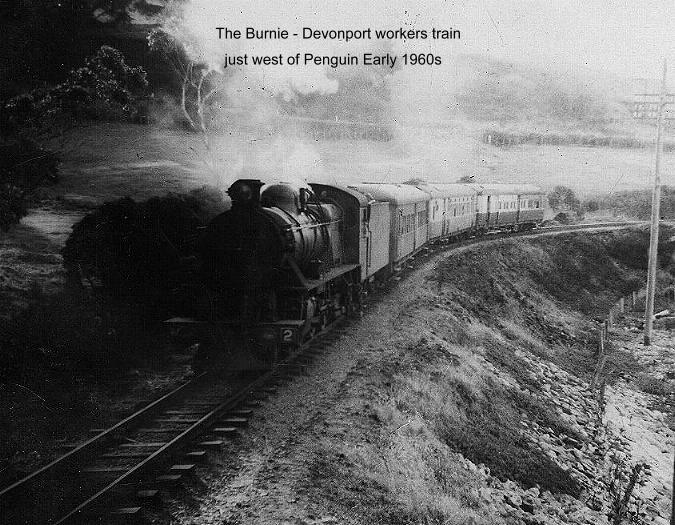
|
|
Locomotive M2 4-6-2 on the approx. 30 mile run, returning from Burnie on a weekday
afternoon in the early 1960s
with the Devonport-Burnie workers train -- which carried mainly commuters to
and from the Paper mills at Burnie. Two of the cars are ex SP steam powered railcars
which were converted to loco hauled cars.
The train which ran close to the edge of Bass Strait for some 20 miles between
Burnie and Ulverstone is pictured just west of Penguin.
|
|
H Class 4-8-2 number 5 with a special tour, arriving back at Devonport
from Deloraine on March 7 1964,
from where a tour to Mole Creek with CCS25 had been run.
H5 was here changed for M6 (next picture)
There were 8 similar locos in the H class.
|
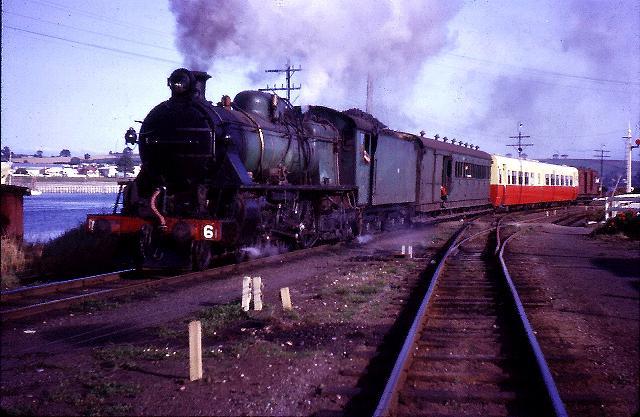
|
|
M6, of a class of 10 similar 4-6-2s, is here in original green
livery, and is shown departing Devonport for Burnie after
changing locomotives from the H shown in the previous
picture. The bow of the Bass Strait Ferry Princess of Tasmania, can be just seen
on the left of the picture, This locomotive was
later painted red for centenary celebrations, and after it was retired, was
taken to Victoria where it has
been in service at the Bellarine
Peninsula Railway between Queenscliff and Drysdale. Four of these locos later had their
4ft 7in driving wheels replaced with smaller 4ft diameter wheels
from out of service Australian Standard Garratts.
These were then reclassified Ma class, being intended for use primarily
on Tasmania's more steeply graded lines. (see next picture)
Click here to see M6 under progressing restoration
at Queenscliff September 2006.
|
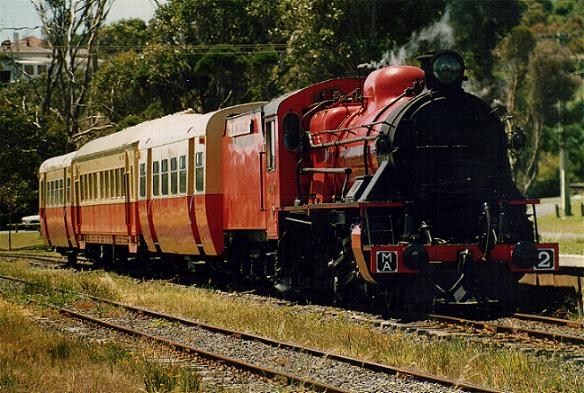
|
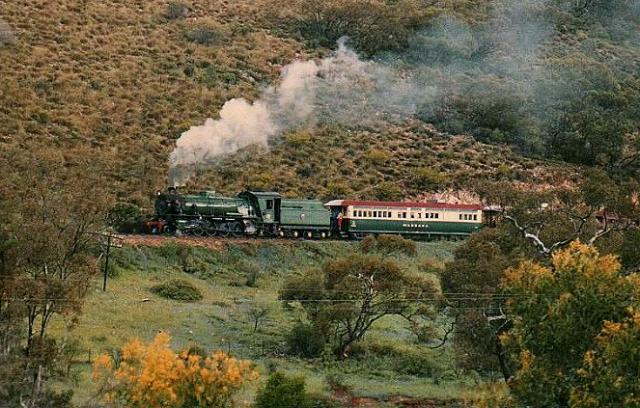
|
|
A former Western Australian Railways 4-8-2 W class steam locomotive
and train in the Pichi Richi Pass through the scenic Flinders Ranges in
the outback of the state of South Australia.
This 3ft 6in gauge railway, was once part of the Central Australia Railway
from Port Augusta to Alice Springs, while
passengers travelling west from the East and south, passed through the
junction of Quorn and onward to western Australia via Port Augusta along this section
where they changed to standard gauge trains to Kalgoolie.
So this section also formed part of the railway system across Australia.
After the 5ft 3in gauge from the south and the 4ft 8-1/2inch gauge section
from the west
eventually joined up at Port Pirie to the east, this section was largely bypassed
by east-west passengers, and was eventually closed after the standard gauge was extended
to Marree from where the
narrower gauge trains which once traversed this section, then started from.
This created a
change of gauge location at Marree
well into the outback.
But the main reason for extending the standard gauge was to
transport coal from Leigh Creek to the Port Augusta power station.
Marree is a little further on.
The line through Pich Richi Pass
was eventually bypassed completely therefore, and laid
in disuse for many years until restored to operation by the
Pichi Richi Preservation Society.
This railway was reopened in sections the first section being
between Quorn and Woolshed Flat. It now operates between Port Augusta
and Quorn.
|
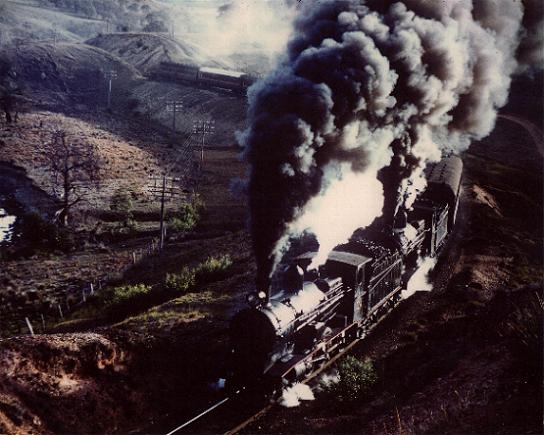
|
|
Frosty morning photo run Canberra special
with 3214 leading another 32 class mid 1960s
|
|
A last run of a S.A.
700 class loco - Special Willunga line 1960s
|
|
Ex Queensland Railways (3' 6" gauge) loco, BB18-1/4 1072, on the
Zig Zag Railway
near Lithgow New South Wales (NSW). The Zig Zag which originally
had NSW 4' 8 1/2" gauge track, and was built in the shape of a Z carved into the mountains
together with tunnels and stone viaducts, by which trains
originally ascended or descended some 600 feet by reversing up or down the middle of the Z before
resuming running in their forward direction. The Zig Zag was bypassed by the use of a different
more direct
route about 1910 after some 40 years operation, during which mishaps were not uncommon.
The original track was dismantled. Tourist trains now run
over the section on 3' 6" track using restored locomotives and cars
from 3' 6" railways from the states Queensland
and South Australia (S.A.). The cars in the picture above are originally from S.A.
|
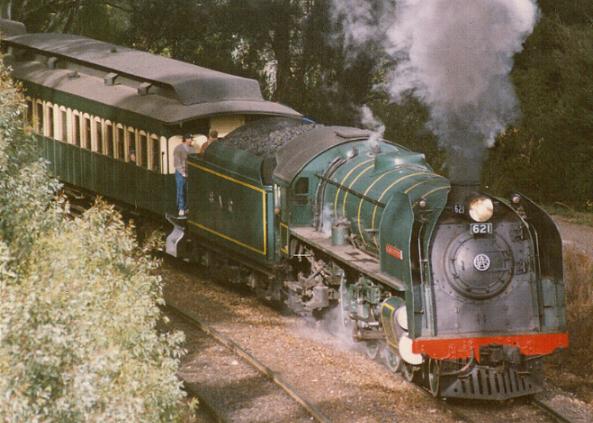
|
|
Preserved 620 'pacific' now under the care of
Steamranger
on a Victor Harbour special climbing the
Adelaide hills in South Australia on the 5' 3" gauge - before
the track was converted to 4' 8 1/2" as part of the project to
standardize the rail gauges between Australian States.
|
|
PB class steam locomotive
and train on the Stoney Creek Falls bridge on
the line between Cairns and Kuranda in North Queensland.
|
Videos
Garratt 6029 to Parkes 1981
from G.Reid on Vimeo.
Three steam trains to Seymour
from G.Reid on Vimeo.
|